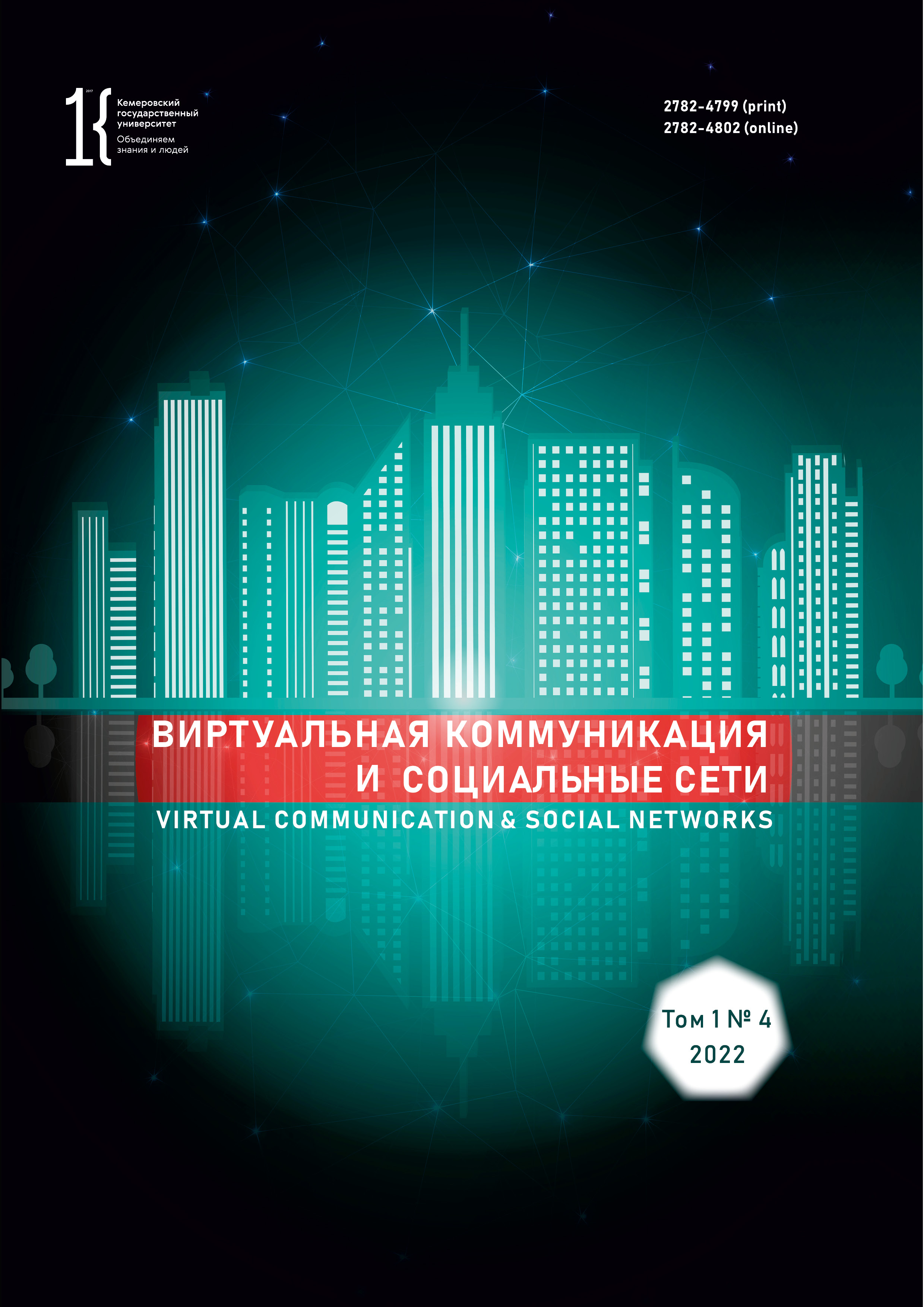Kemerovo, Russian Federation
The features of the communicative behavior of young people in the network discursive space are considered. The purpose of the study is to assess the characteristic linguistic features of young people in social networks. The research material was the data of a questionnaire aimed at identifying the motives and goals of young people in network communication. About 150 people (students of different faculties and courses) were interviewed. An anonymous survey was conducted by 100 schoolchildren (the age of teenagers ranged from 12 to 17 years). On the youth platforms of the Runet, data from Internet discussions and comments from communication participants are collected. The results of the study showed that the reconstruction of the portrait of the linguistic personality of a young user of social networks is associated with the following factors. Firstly, a special digital linguistic personality is being formed in the Internet space. It acts as a synthesis of a real linguistic personality with its constructed image. It has its own language features. They are revealed in a new vocabulary, modified by the youth itself, slang. A modern student in the context of social networks has a synthesis of two spheres – educational and communicative. The vocabulary of a modern teenager is reduced to simple colloquial expressions, often profanity (obscene words), jargon. The speech of teenagers has become very everyday and real. Most words of modern slang have several features: these are mostly abbreviated and borrowed words. The dynamism of the modern world is reflected in the very frequent use of nouns with event meaning and verbs. Secondly, against this background, the text is increasingly accompanied by illustrations, stickers, emoticons and many others. The importance of social networks for the self-expression of young people is emphasized.
communicative portrait, linguistic personality, social network, discourse, youth discourse
1. Arzumanova R. A., Drogova G. M. Communicative portrait of a future doctor: to the statement of a problem. Polylinguality and Transcultural Practices, 2015, (1): 7-11. (In Russ.) EDN: https://elibrary.ru/TMGDCH
2. Bezukladnikov K. E., Kruze B. A., Zhigalev B. A., Sorokoumova S. N., Egorova P. A. Psychological safety in the school and university linguistic education. Jazyk i kul’tura, 2018, (44): 134-151. (In Russ.) https://doi.org/10.17223/19996195/44/9
3. Golev N. D. Codes of modern written communication: acoustic-auditory vs. manual-visual. Vestnik Kemerovskogo gosudarstvennogo universiteta, 2021, 23(4): 1024-1031. (In Russ.) https://doi.org/10.21603/2078-8975-2021-23-4-1024-1031
4. Golev N. D., Irkova A. V. Communicative portrait of the modern Russian schooler and student - users of social networks and other forms of virtual communication. Fundamental problems of the humanities: experience and development prospects of RFBR research projects: Proc. All-Russ. Sci. Conf. with Intern. participation, Barnaul, 24-26 Sep 2020. Barnaul: AltSPU, 2020, 221-224. (In Russ.) EDN: https://elibrary.ru/KYGWNE
5. Guruleva T. L. Comparative analysis of the communicative behavior of the ethnic language personality: parameters and technology of the description of a speech portrait. Kul'tura i tsivilizatsiya, 2016, 6(6A): 326-335. (In Russ.) EDN: https://elibrary.ru/YRPMGF
6. Dikov A. V. Digital educational resources and social networks. Moscow: Ai Pi Ar Media, 2022, 256. (In Russ.) EDN: https://elibrary.ru/NWEXFE
7. Ivanov A. V., Fotieva I. V. Social and psychological portrait of modern youth: evaluation of the system of values. Mir nauki, kul’tury, obrazovaniya, 2014, (4): 394-396. (In Russ.) EDN: https://elibrary.ru/SYAADJ
8. Kibrik A. A. Russian multichannel discourse. Part I. Setting up the problem. Psihologicheskij zhurnal, 2018, 39(1): 70-80. (In Russ.) https://doi.org/10.7868/S0205959218010075
9. Koshkarova N. N. Axiological characteristics of new sensibility discourse: how language reflects the reality. Human Being: Image and Essence. Humanitarian Aspects, 2021, (2): 53-68. (In Russ.) https://doi.org/10.31249/chel/2021.02.04
10. Koshkarova N. N., Yakovleva E. M. Discourse of new emotionality: Communicative practices of digital reality. Political Linguistics, 2019, (5): 147-152. (In Russ.) https://doi.org/10.26170/pl19-05-15
11. Larionov V. G., Sheremetyeva E. N., Gorshkova L. A. Digital transformation of higher education: technologies and digital competencies. Vestnik of Astrakhan State Technical University. Series: Economics, 2021, (2): 61-69. (In Russ.) https://doi.org/10.24143/2073-5537-2021-2-61-69
12. Social Networks: complex linguistic analysis, ed. Kim L. G. Kemerovo: KemSU, 2021, vol. 1, 300. (In Russ.) EDN: https://elibrary.ru/KEGPIU
13. Strategizing of the digital Kuzbass region. Ed. Kvint V. L. Kemerovo: KemSU, 2021, 434. (In Russ.) https://doi.org/10.21603/978-5-8353-2796-6
14. Fundamental linguistics and problems of forensic examination: social networks as an object of scientific and expert analysis: Proc. Intern. Sci. Conf., Moscow, 5-6 Oct 2021. Moscow: Pushkin Institute, 2022, 436. (In Russ.) EDN: https://elibrary.ru/ZHASCX
15. Corbisiero F. How to study online networking: the role of social network analysis. Punziano G., Paoli A. D. Handbook of research on advanced research methodologies for a digital society. IGI Global, 2022. C. 360-374. https://doi.org/10.4018/978-1-7998-8473-6.ch022
16. Abbasianjahromi H., Etemadi A. Applying social network analysis to identify the most effective persons according to their potential in causing accidents in construction projects. International Journal of Construction Management, 2022, 22(6): 1065-1078. https://doi.org/10.1080/15623599.2019.1683688
17. Aguilar-Gallegos N., Klerkx L., Romero-García L. E., Martínez-González E. G., Aguilar-Ávila J. Social network analysis of spreading and exchanging information on Twitter: the case of an agricultural research and education centre in Mexico. The Journal of Agricultural Education and Extension, 2022, 28(1): 115-136. https://doi.org/10.1080/1389224X.2021.1915829
18. Chen L., Chen J., Xia C. Social network behavior and public opinion manipulation. Journal of Information Security and Applications, 2022, 64. https://doi.org/10.1016/j.jisa.2021.103060















